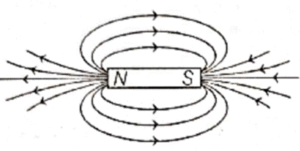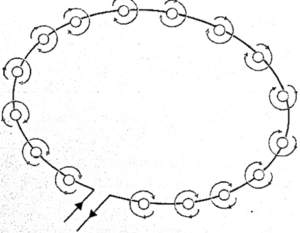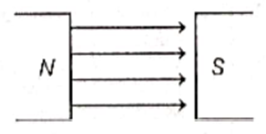Magnetic Effects of Electric Current
Class-10-CBSE-NCERT-Science-Chapter-12
Solutions
In−text Solutions (Page 196)
Question 1. Why does a compass needle get deflected when brought near a bar magnet?
The magnetic field of the magnet exerts force on both the poles of the compass needle. The forces experienced by the two poles are equal and opposite. These two forces form a couple which deflects the compass needle.
In−text Solutions (Page 200)
Question 1. Draw magnetic field lines around a bar magnet.
Question 2. List the properties of magnetic field lines.
The magnetic field lines have the following properties:
- They originate from North pole of a magnet and end at its South pole, by convention.
- These lines are closed and continuous curves.
- They are crowded near the poles, where the magnetic field is strong and separated far from the poles, where the magnetic field is weak.
- Field lines never intersect with each other. If they do, that would mean that there are two directions of the magnetic field at the point of intersection, which is impossible.
- The relative strength of the magnetic field is shown by the degree of closeness of the field lines. Closer the lines, more will be the strength and farther the lines, less will be the magnetic field strength.
Question 3. Why don’t two magnetic field lines intersect each other?
If two magnetic lines of force intersect each other, it would mean that there are two directions of the magnetic field at the point of intersection, which is not possible.
In−text Solutions (Page 201-202)
Question 1. Consider a circular loop of wire lying in the plane of the table. Let the current pass through the loop clockwise. Apply the right-hand rule to find out the direction of the magnetic field inside and outside the loop.
Question 2. The magnetic field in a given region is uniform. Draw a diagram to represent it.
Question 3. Choose the correct option.
The magnetic field inside a long straight solenoid-carrying current
(a) is zero.
(b) decreases as we move towards its end.
(c) increases as we move towards its end.
(d) is the same at all points.
(d) Magnetic field inside a solenoid is same at all the points.
In−text Solutions (Page 203-204)
Question 1. Which of the following property of a proton can change while it moves freely in a magnetic field? (There may be more than one correct answer.)
(a) mass (b) speed (c) velocity (d) momentum
(d) momentum
Proton is a charged particle. When it moves in a magnetic field, a magnetic force is applied due to which its velocity and hence the momentum changes.
Question 2. In Activity 12.7, how do we think the displacement of rod AB will be affected if
(i) current in rod AB is increased;
(ii) a stronger horse-shoe magnet is used; and
(iii) length of the rod AB is increased?
In Activity 12.7, the force acting on a current carrying conductor when placed in a magnetic field is illustrated.
(i) When current in rod AB is increased, the displacement of rod is increased, as force acting on rod is directly proportional to the current flowing through it. On increasing the current, force on the conductor increases.
(ii) If a stronger horse-shoe magnet is used, then the strength of magnetic field will increase leading to greater force on the rod. Due to this, the displacement of rod will increase.
(iii) Displacement of conductor is increased with an increase in length of the conductor. On increasing the length, more force will act on the conductor.
Question 3. A positively-charged particle (alpha-particle) projected towards west is deflected towards north by a magnetic field. The direction of magnetic field is
(a) towards south (b) towards east (c) downward (d) upward
(d) upward
The positively charged particle is moving towards West, i.e. the direction of current is towards West (current flows in the direction of the motion of positive charge).
The particle is deflected towards North, so the direction of force is towards North. Thus, from Fleming's left hand rule, the direction of magnetic field is in upward direction.
In−text Solutions (Page 205)
Question 1. Name two safety measures commonly used in electric circuits and appliances.
(i) Earthing and, (ii) Electric fuse.
Question 2. An electric oven of 2 kW power rating is operated in a domestic electric circuit (220 V) that has a current rating of 5 A. What result do you expect? Explain.
Given : P = 2 Kw = 2000 W, V = 220 V
The electric oven draws a current given by
I = P/V = 2000/220 = 9.09 A
Thus the electric oven draws current much more than the current rating of 5 A. That is the circuit is overloaded. Due to excessive current, the fuse wire blows and the circuit is broken.
Question 3. What precaution should be taken to avoid the overloading of domestic electric circuits?
As a result of overloading, the connecting wires get over-heated and the appliances may get damaged. To avoid this, the following safety measures must be taken:
- The wires used in the circuit must be coated with good insulating materials like PVC, etc.
- The circuit must be divided into different sections and a safety fuse must be used in each section.
- High power appliances like air-conditioner, refrigerator, water heater, etc., should not be used simultaneously.
Exercise Solutions
Question 1. Which of the following correctly describes the magnetic field near a long straight wire?
(a) The field consists of straight lines perpendicular to the wire.
(b) The field consists of straight lines parallel to the wire.
(c) The field consists of radial lines originating from the wire.
(d) The field consists of concentric circles centred on the wire.
(d) The field consists of concentric circles centred on the wire.
Question 2. At the time of short circuit, the current in the circuit
(a) reduces substantially.
(b) does not change.
(c) increases heavily.
(d) vary continuously.
(c) increases heavily.
Question 3. State whether the following statements are true or false.
(a) The field at the centre of a long circular coil carrying current will be parallel straight lines.
(b) A wire with a green insulation is usually the live wire of an electric supply.
(i) True
(ii) False, the wire with green insulation is the earth wire not the live wire.
Question 4. List two methods of producing magnetic fields.
Two methods of producing magnetic field are as given below:
- Passing electric current through a straight conductor/circuit.
- Passing electric current through a circular loop.
Question 5. When is the force experienced by a current–carrying conductor placed in a magnetic field largest?
The force experienced by a current carrying conductor placed in a magnetic field is the largest when conductor is kept perpendicular to the direction of the magnetic field.
Question 6. Imagine that you are sitting in a chamber with your back to one wall. An electron beam, moving horizontally from back wall towards the front wall, is deflected by a strong magnetic field to your right side. What is the direction of magnetic field?
According to Fleming's left hand rule, the direction of magnetic field inside the chamber is vertically downward.
Question 7. State the rule to determine the direction of a
(i) magnetic field produced around a straight conductor-carrying current,
(ii) force experienced by a current-carrying straight conductor placed in a magnetic field which is perpendicular to it, and
(iii) current induced in a coil due to its rotation in a magnetic field.
(i) Right hand thumb rule: If the current carrying conductor is held in the right hand such that the thumb points in the direction of the current, then the direction of the curl of the fingers will given the direction of the magnetic field.
(ii) Fleming's left hand rule: Stretch the forefinger, the central finger and the thumb of the left hand mutually perpendicular to each other. If the forefinger points in the direction of the magnetic field, the central finger in the direction of current, then the thumb points in the direction of force in the conductor.
(iii) Fleming's right hand rule: Stretch the thumb, forefinger and the central finger of the right hand mutually perpendicular to each other. If the forefinger points in the directions of magnetic field, thumb in the direction of motion of the conductor, then the central finger points in the direction of current induced in the conductor.
Question 8. When does an electric short circuit occur?
As a result of live wire touching the neutral wire, the resistance offered to the flow of current becomes almost zero and this is called short-circuiting. In this situation, a large current flow through the circuit, causes a spark or damage to the appliance.
Question 9. What is the function of an earth wire? Why is it necessary to earth metallic appliances?
The earth wire connects the metallic body of the high powered appliance to the earth. It is a safety measure which ensures any leakage of current of the metallic body of the appliance keeps its potential equal to that of the earth (zero volt) and the user may not get a severe electric shock.
Click on below links to get PDF from store
PDF : Class 10th-Science-Chapter-12-Magnetic Effects of Electric Current-Notes
PDF : Class 10th-Science-Chapter-12-Magnetic Effects of Electric Current-Solution
All Chapters Class-10-Science-NCERT- Notes set (13-PDF) Rs.73
All Chapters Class-10-Science NCERT-Solution set (13-PDF) Rs.55
All Chapters Class-10-Science-NCERT- Notes & Solutions set (26-PDF) Rs.105
Main Page : NCERT-Class-10-Science – All chapters notes, solutions, videos, test, pdf.
Previous Chapter : Chapter 11 : Electricity – Online Solutions
Next Chapter : Chapter-13-Our Environment – Online Solutions



We reply to valid query.